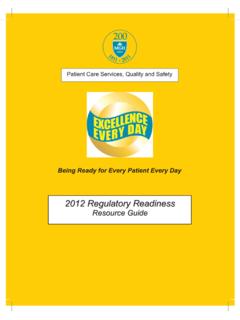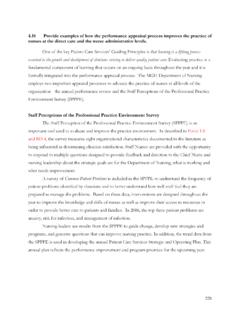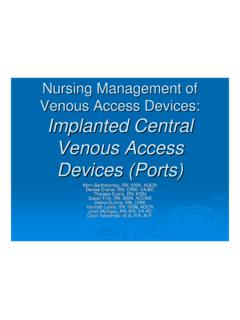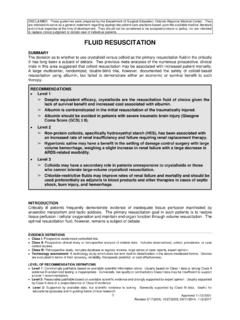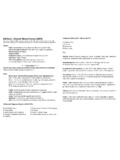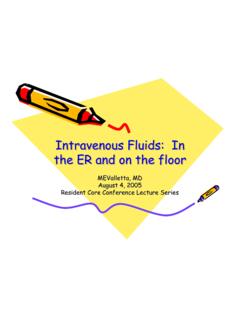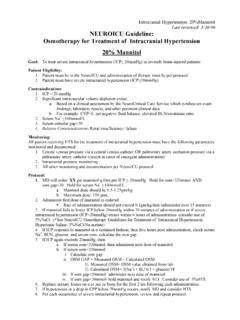Transcription of Nursing Management of Venous Access Devices: An Overview ...
1 Nursing Management of Nursing Management of Venous Access Devices: Venous Access Devices: An Overview of Central An Overview of Central Venous Access Venous Access Devices Devices Mimi Bartholomay, RN, MSN, AOCNMimi Bartholomay, RN, MSN, AOCND enise Denise DreherDreher, RN, CRNI, VA, RN, CRNI, VA--BCBCT heresa Evans, RN, MSNT heresa Evans, RN, MSNS usan Finn, RN, MSN, AOCNSS usan Finn, RN, MSN, AOCNSD ebra Guthrie, RN, CRNID ebra Guthrie, RN, CRNIH annah Lyons, RN, MSN, AOCNH annah Lyons, RN, MSN, AOCNJ anet Mulligan, RN, MS, VAJanet Mulligan, RN, MS, VA--BCBCC arol Carol TyksienskiTyksienski, , , , , , Venous Access Devices Central Venous Access Devices ((CVADsCVADs)) Peripherally Inserted Central Catheters Peripherally Inserted Central Catheters ((PICCsPICCs)) NonNon--tunneled catheters: tunneled catheters: SubclavianSubclavian/ / Jugular / Femoral LinesJugular / Femoral Lines Tunneled catheters: Tunneled catheters: HickmansHickmans/ / BroviacsBroviacs/ / GroshongsGroshongs/ Small Bore/ Small Bore Implanted ports: PortImplanted ports: Port--aa--cathscaths/ Passports/ PassportsCentral Central VADsVADs.
2 First line of defense, not a device of last ..first line of defense, not a device of last resortresort Candidates:Candidates: LongLong--term therapies ( > one week)term therapies ( > one week) TPNTPN Chemotherapy / vesicantsChemotherapy / vesicants Drugs with pH <5 or >9 Drugs with pH <5 or >9 Long term antibiotic therapyLong term antibiotic therapy hypertonic solutions ( hypertonic solutions (osmolalityosmolality>600mOsm/L) ex.>600mOsm/L) 3% salinesaline Limited Venous accessLimited Venous accessVerification of Verification of Central LinesCentral Lines Confirmation of type of central line and line Confirmation of type of central line and line placement MUST be verified before useplacement MUST be verified before use Until verification is complete, the catheter Until verification is complete, the catheter must be marked with a red must be marked with a red unconfirmed unconfirmed cathetercatheter stickersticker PheresisPheresisand dialysis catheters will have a and dialysis catheters will have a specific label attached to the dressingspecific label attached to the dressing Refer to Nursing Policies and Procedures Refer to Nursing Policies and Procedures Trove 05 Trove 05--0303--01 and 0501 and 05--0303--0404 Sources to Use for Central Line Sources to Use for Central Line IdentificationIdentification Chest xChest x--ray or CT scanray or CT scan Interventional Radiology reportInterventional Radiology report Operative noteOperative note Discharge summaryDischarge summary Referring MD noteReferring MD note Outside hospital transfer noteOutside hospital transfer note PatientPatient--provided documentationprovided documentationCentral VAD: Catheter Tip Central VAD.
3 Catheter Tip PlacementPlacement Chest xChest x--ray mandatory before initial use, and if ray mandatory before initial use, and if patient is readmitted to the hospital with an patient is readmitted to the hospital with an existing PICC or undocumented VADexisting PICC or undocumented VAD MUST be MUST be centralcentral Superior vena cava (SVC)Superior vena cava (SVC) CavoatrialCavoatrialjunction (superior vena cava/right junction (superior vena cava/right atrialatrialjunction (SVC/RA junction)junction (SVC/RA junction) Right atrium (RA); exception is Right atrium (RA); exception is PICCsPICCs Femoral lines: tip in thoracic inferior vena cava (IVC) Femoral lines: tip in thoracic inferior vena cava (IVC) above level of the diaphragmabove level of the diaphragmVenous anatomy of upper extremity Venous anatomy of upper extremity veinsveinsRetrieved from Treadwell Library 12/11/09 Central Central VADsVADs::MalpositionedMalpositionedcath eterscatheters Catheter should not be used as a central VAD Catheter should not be used as a central VAD until it is repositioned and tip is confirmed to be until it is repositioned and tip is confirmed to be in a central locationin a central location Interventions for Interventions for PICCPICCss: : MalpositionedMalpositionedPICCsPICC sare not automatically not automatically removed.))
4 PullPull--back: if tip in right atrium, right ventricle, some back: if tip in right atrium, right ventricle, some contralateralcontralateralPICCsPICCs, or patient is experiencing cardiac , or patient is experiencing cardiac irritability, the PICC may be pulled back by the IV irritability, the PICC may be pulled back by the IV nurse or interventional or interventional radiology. Other tip locations may be exchanged by IV nurse or Other tip locations may be exchanged by IV nurse or Interventional Radiology (IR).Interventional Radiology (IR).Central Central VADsVADs::MalpositionedMalpositionedcath eterscatheters Interventions for Interventions for PICCsPICCs(cont.):(cont.): Catheter exchange is considered if: Catheter exchange is considered if: Tip is in the jugular, contraTip is in the jugular, contra--lateral vein, coiled or looped. lateral vein, coiled or looped. Most coiled or looped Most coiled or looped PICCsPICC sare managed by managed by IR.
5 Patient needs more lumens for therapy or patient needs a Patient needs more lumens for therapy or patient needs a nonnon--violated line for TPN initiation. violated line for TPN initiation. Individual patient anatomy or disease may not Individual patient anatomy or disease may not allow centrallyallow centrally--placed lines and need is placed lines and need is determined on an individual patient case on an individual patient case MeasurementsVein MeasurementsLengthLengthDiameterDiameter Flow RateFlow RateCephalicCephalic38cm38cm6mm6mm4040-- 90ml/min90ml/minBasilicBasilic24cm24cm8m m8mm9090--150 ml/min150 ml/minAxillaryAxillary13cm13cm16mm16mm15 0150--350ml/min350ml/minSubclavianSubcla vian6cm6cm19mm19mm350350--800ml/min800 VAD Care and Maintenance: Central VAD Care and Maintenance: FlushingFlushing Always use a 10ml or larger syringe to flush or Always use a 10ml or larger syringe to flush or administer medications. Smaller syringes have administer medications.
6 Smaller syringes have increased flushing pressure that cause catheter flushing pressure that cause catheter rupture. Note:Note:some presome pre--filled syringes smaller than 10ml filled syringes smaller than 10ml have syringe barrel equal to a 10 ml syringe and are have syringe barrel equal to a 10 ml syringe and are acceptable to useacceptable to use NO heparin for heparinNO heparin for heparin--induced thrombocytopenia (HIT) induced thrombocytopenia (HIT) positive patients: flush with saline 10mlpositive patients: flush with saline 10ml Heparin NOT needed for Heparin NOT needed for saline only/ saline only/valvedvalved devicesdevices Flush IMMEDIATELY postFlush IMMEDIATELY post--infusion and after blood infusion and after blood drawingdrawing Use pushUse push--pause/pause/pulsatilepulsatileflus h method flush method (see module 1 for description)(see module 1 for description)Central VAD Care & Maintenance: Central VAD Care & Maintenance.
7 HeparinHeparin To minimize risk of unintended systemic anticoagulation To minimize risk of unintended systemic anticoagulation from frequent flushing, consider piggyfrom frequent flushing, consider piggy--backing backing medications into an ordered infusionmedications into an ordered infusion Adult Adult guidelineguideline : recommended maximum per 24 : recommended maximum per 24 hours for intermittent flushes should not exceed 2,000 hours for intermittent flushes should not exceed 2,000 unit heparin unit heparin Pediatrics Pediatrics guidelineguideline : maximum heparin per 24 hours : maximum heparin per 24 hours should not exceed 75 units per kg or 2,000 units in 24 should not exceed 75 units per kg or 2,000 units in 24 hourshours----Obtain order for VAD heparin flush to enable EMAR Obtain order for VAD heparin flush to enable EMAR documentationdocumentation Fun factFun fact : heparin does NOT dissolve existing clots; it : heparin does NOT dissolve existing clots; it helps prevent future clotshelps prevent future clotsAdult Adult HeparinizationHeparinizationChart (per lumen)Chart (per lumen)MGH Nursing Policies and Procedures Trove 05 MGH Nursing Policies and Procedures Trove 05--0303--0606 After completion of any After completion of any infusion or blood or blood not in use flush at least When not in use flush at least 11--2 times a times a 10 units/ml; flush Heparin 10 units/ml; flush with 5 ml (50 units).
8 With 5 ml (50 units).HickmansHickmans(tunneled catheters)(tunneled catheters)Type of CatheterType of CatheterRoutine FlushingRoutine FlushingFrequency of FlushFrequency of FlushImplanted ports: Implanted ports: PortPort--aa--cathscathsPower portsPower portsPassportsPassportsHeparin 100 units/ml; flush Heparin 100 units/ml; flush with 5 ml (500 units).with 5 ml (500 units).After completion of any After completion of any infusion or blood sampling. infusion or blood sampling. When When deaccessingdeaccessingor doing aor doing amonthly flush to maintain monthly flush to maintain patency if port is not in patency if port is not in active Adult HeparinizationHeparinizationContinuedCon tinuedAfter completion of any After completion of any infusion or blood sampling. infusion or blood sampling. When not in use, remove and When not in use, remove and 1000 units/ml; instillHeparin 1000 units/ml; instillvolume of catheter (printedvolume of catheter (printedon each lumen) plus on each lumen) plus volume of cap (currently of cap (currently for ml for MaxPlusMaxPlus).)
9 If catheter). If cathetervolume not legible, contact volume not legible, contact CNS or Interventional CNS or Interventional Radiology for for must be Heparin must be withdrawnwithdrawnfrom the lumen from the lumen prior to flushing or prior to flushing or infusinginfusingthrough the through the pheresispheresiscatheter, in order catheter, in order to avoid excess or to avoid excess or inadvertent (largeCatheters (largebore catheters used forbore catheters used forpheresispheresis, bone marrow , bone marrow transplant)transplant)[Note: May be confused [Note: May be confused with a Hickman or with a Hickman or dialysis catheter.] dialysis catheter.] Type of CatheterType of CatheterRoutine FlushingRoutine FlushingFrequency of FlushFrequency of FlushSmall Bore Tunneled Small Bore Tunneled Central Line CathetersCentral Line Catheters( Bard ( Bard PowerlinePowerline) ) Heparin 10 units/ml; flush Heparin 10 units/ml; flush with 5 ml (50 units).
10 With 5 ml (50 units).After completion of any After completion of any infusion or blood sampling, at infusion or blood sampling, at least once every 24 once every 24 Adult HeparinizationHeparinizationContinuedCon tinuedFlush after each use or at Flush after each use or at least every 7 days when notleast every 7 days when notin use. in use. Although these do not requireAlthough these do not requireheparin, OK to use if , OK to use if is essential to use pushIt is essential to use push--pause technique when pause technique when flushing salineflushing saline --only NOT require Heparin. Do NOT require Heparin. Use preservativeUse preservative--free free Normal saline : flush with at Normal saline : flush with at least 20 ml after blood least 20 ml after blood draws or discontinuing TPN; draws or discontinuing TPN; 10 ml after meds or for 10 ml after meds or for routine only PICCsPICC sand and ValvedValvedcatheters catheters ( ( VaxcelVaxcelor Bard or Bard PowerPICCP owerPICCSOLO) SOLO) After completion of any After completion of any infusion or blood sampling, at infusion or blood sampling, at least once every 24 once every 24 10 units/ml; flush Heparin 10 units/ml; flush with 5 ml (50 units).
